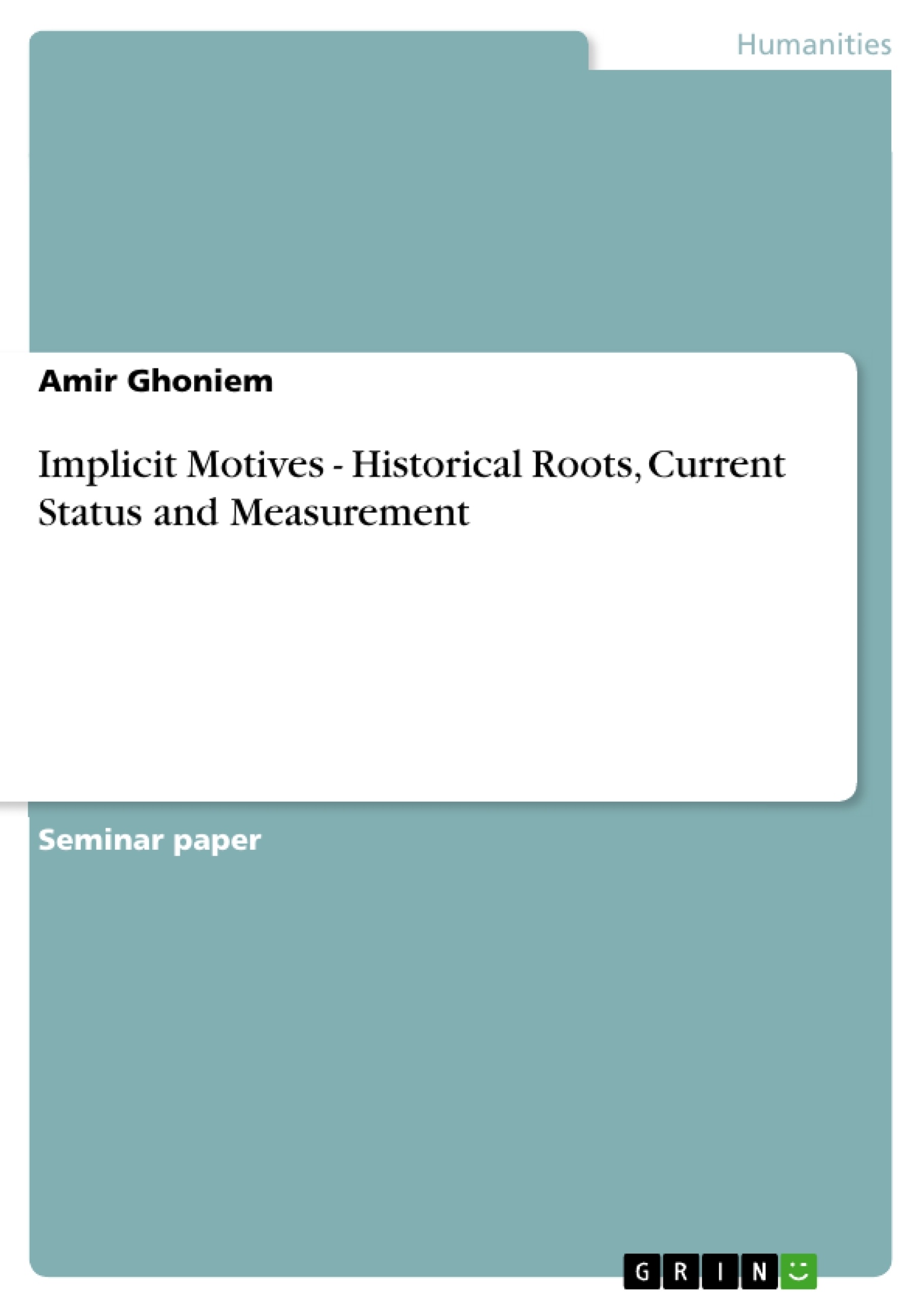Table of Contents
Definition………………………………………………………………………………………….3
History……………………………………………………………………………………………..3
Current Status……………………………………………………………………………………...6
Current Theory…………………………………………………………………………………….8
Affiliation Motive ………………………………………………………………………...8
Power Motive ……………………………………………………………………………10
Achievement Motive …………………………………………………………………….13
How to Measure Implicit Motives……………………………………………………………….14
Measures of Implicit Motives……………………………………………………………………17
Picture Story Exercise……………………………………………………………………17
Thematic Apperception Test …………………………………………………………….18
Implicit Association Test ………………………………………………………………..19
Multi Motive Grid ……………………………………………………………………….20
Achievement Motive Grid ………………………………………………………………21
Multi Motive Grid: Short Version ………………………………………………………22
Operant Motive Test …………………………………………………………………….23
References ……………………………………………………………………………………….24
Appendix 1……………………………………………………………………………………….29
Appendix 2 ………………………………………………………………………………………30
Inhaltsverzeichnis (Table of Contents)
- Definition
- History
- Current Status
- Current Theory
- Affiliation Motive
- Power Motive
- Achievement Motive
- How to Measure Implicit Motives
- Measures of Implicit Motives
- Picture Story Exercise
- Thematic Apperception Test
- Implicit Association Test
- Multi Motive Grid
- Achievement Motive Grid
- Multi Motive Grid: Short Version
- Operant Motive Test
- References
- Appendix 1
- Appendix 2
Zielsetzung und Themenschwerpunkte (Objectives and Key Themes)
This work aims to provide a comprehensive overview of implicit motives, tracing their historical development, current theoretical understanding, and various measurement techniques. It explores the evolution of research in this field, highlighting key debates and advancements.
- The historical development of implicit motive research
- The definition and nature of implicit motives
- The three primary motivational needs: achievement, power, and affiliation
- Different methods for measuring implicit motives
- The evolution of understanding and controversies surrounding the measurement and interpretation of implicit motives.
Zusammenfassung der Kapitel (Chapter Summaries)
Definition: This section defines implicit motives as relatively stable and unconscious needs, shaped by learning and experience, and influencing feelings and behaviors without conscious awareness. It establishes the foundational concept for the subsequent exploration of the topic.
History: This chapter details the origins of implicit motive research, starting with McClelland and Atkinson's pioneering work in the late 1940s. It highlights their initial use of the Thematic Apperception Test (TAT) and the subsequent focus on achievement, power, and affiliation motives. The chapter also describes the initial success and subsequent stagnation and confusion within the field, touching upon conflicting interpretations and methodologies used to measure these motives. The narrative outlines the initial promise of the research and the hurdles it faced.
Current Status: This section (inferred from the provided text) would likely discuss the resurgence of interest in implicit motives, following earlier setbacks. It would probably cover the reconciliation of differing views on the nature of implicit motives and their measurement, potentially incorporating the integration of cognitive psychology findings on implicit processes. This would likely involve a discussion of the different types of behaviors predicted by implicit and self-reported motives.
Schlüsselwörter (Keywords)
Implicit motives, achievement motivation, power motivation, affiliation motivation, Thematic Apperception Test (TAT), projective measures, unconscious motivation, behavioral prediction, self-attributed motives, history of motivation research.
Frequently Asked Questions: A Comprehensive Language Preview of Implicit Motives
What is the main topic of this document?
This document provides a comprehensive overview of implicit motives. It covers their definition, historical development, current theoretical understanding, and various measurement techniques.
What are implicit motives?
Implicit motives are defined as relatively stable and unconscious needs that are shaped by learning and experience. They influence feelings and behaviors without conscious awareness.
What is the historical context of implicit motive research?
The research originates from McClelland and Atkinson's pioneering work in the late 1940s, initially using the Thematic Apperception Test (TAT) to focus on achievement, power, and affiliation motives. The field experienced initial success followed by stagnation and confusion due to conflicting interpretations and methodologies. The document traces this evolution, highlighting both initial promise and subsequent hurdles.
What are the three primary implicit motives discussed?
The three primary motivational needs explored are achievement, power, and affiliation.
How are implicit motives measured?
The document details various methods for measuring implicit motives, including the Picture Story Exercise, Thematic Apperception Test (TAT), Implicit Association Test, Multi Motive Grid, Achievement Motive Grid, Multi Motive Grid (Short Version), and Operant Motive Test.
What is the current status of implicit motive research?
The document suggests a resurgence of interest in implicit motives, following earlier setbacks. It likely covers the reconciliation of differing views on their nature and measurement, possibly integrating findings from cognitive psychology on implicit processes and discussing the different types of behaviors predicted by implicit versus self-reported motives.
What are the key themes explored in this work?
Key themes include the historical development of implicit motive research; the definition and nature of implicit motives; the three primary motivational needs (achievement, power, and affiliation); different methods for measuring implicit motives; and the evolution of understanding and controversies surrounding the measurement and interpretation of implicit motives.
What are the key words associated with this topic?
Keywords include: Implicit motives, achievement motivation, power motivation, affiliation motivation, Thematic Apperception Test (TAT), projective measures, unconscious motivation, behavioral prediction, self-attributed motives, and history of motivation research.
What is included in the table of contents?
The table of contents includes sections on Definition, History, Current Status, Current Theory (with subsections on Affiliation, Power, and Achievement Motives), How to Measure Implicit Motives (with subsections detailing various measurement techniques), References, and Appendices 1 & 2.
- Citation du texte
- Cand.-Psych. Amir Ghoniem (Auteur), 2011, Implicit Motives - Historical Roots, Current Status and Measurement, Munich, GRIN Verlag, https://www.grin.com/document/210848



